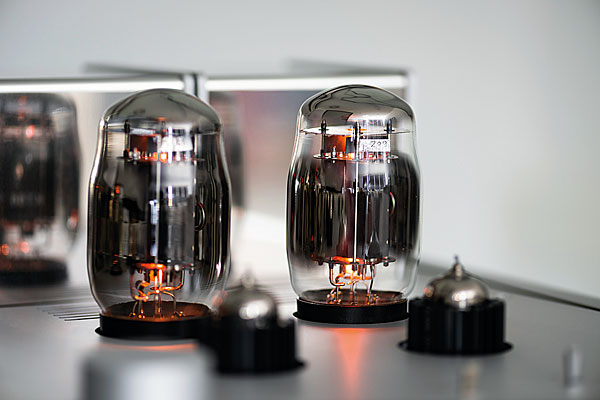EAT E-Glo i Integrated Tube Amp Page 2
One matter to dispense with as quickly as possible is triode vs ultralinear, so as not to obscure hearing what the E-Glo i does regardless. While obviously a desirable feature, it needn't be a source of agitation for audiophiles susceptible to the torment of choices. All it requires are a few favourite tracks and no distractions.
As it's just a matter of flicking a switch, triode vs ultralinear is not an either/or situation. Both are available here at all times, so it's not like choosing solid-state or valve. You use either according to taste or whatever strikes your fancy, so note: I'll not offer a definitive choice.
 Walking Tall
Walking Tall
The reason for this is that I typically prefer the warmth of triode mode (though I am not convinced by single-ended triodes), even though I also worship a few vintage ultralinear classics. Instead, I will cite either where appropriate. If there's an overall problem with the triode vs ultralinear dilemma, it's that differences can be either too subtle to matter (in the case of the E-Glo i, the level change is minimal), or so drastic that one's preference is immediately determined.
What muddles this is that it's both a hardware issue, eg, the Tannoy speakers sounded smoother with the amp in ultralinear mode while the JBLs benefited from triode, and it varies from source-to-source and recording-to-recording.
How to deal with this variable aspect of the two modes? I played the open-reel tape of The Beatles' Sgt Pepper [Capitol L2653], the corresponding US vinyl version [SMAS 2653] and the new mixes on LP [Parlophone PCS7027] and CD [Parlophone 0255745532 8], ensuring level matching and comparing UK mix with US mix, and 2017 remastered LP with the same on CD.
First, let's portray the overall nature of the E-Glo i. Regardless of the position of the toggle, the immediate, stand-out qualities are inherent, undeniable warmth and truly vast soundstage properties. And these were constant regardless of source, material – or mode. This amplifier sounds both intimate and huge. How's that for seemingly incompatible virtues?
Repeatedly cited and patently impressive, too, was a rarely-noted element which never attains the importance of image specificity, bass control, transient attack or other qualities, and that was image height. Admittedly, this was enabled in no small part by playback through the champions of that trait, the LS3/5As. The music always hovered above the speakers, topping a soundstage of cavernous depth and wall-to-wall boundaries.

Float On
Revelations started with the crowd noises which open Sgt Pepper, carrying on through 'With A Little Help From My Friends', the latter's width bordering on the astounding, the former audibly floating in the room. Each instrument was so perfectly located that – especially with eyes closed – the experience defies you to identify the speaker as a box or a panel. Percussion was as crisp as a Frito, the E-Glo i being atypically precise for any valve design, and even in triode mode. The snap was as fast and clear-cut as I've heard from solid-state amps of ten times the power and five times the price.
Further trashed preconceptions came as the E-Glo i did not attempt to assuage the virulently spitty top-end of Belafonte Returns To Carnegie Hall [RCA FTO 6002]
as would a mushy valve amp of yore. An open-reel tape in RCA's Living Stereo range, it is the sequel to one of the most admired audiophile recordings of all time. I wondered if during the year between the first album and this follow-up, someone had fallen in love with the worst-sounding vocal mic then available. Despite this, the soundstage remained breathtaking, so all was not lost. But back to the Beatles.
Finesse And Fluidity
What the contrasting formats offered was an opportunity which you, too, can replicate if, like me, you're a schmuck who buys both LP and CD... and tape as well. The ultralinear mode tightened up all-analogue recordings, while the triode mode increased the warmth of the digital versions. Digital material thus grew less likely to induce fatigue in this mode.
'She's Leaving Home' places Paul's vocals in front of massed strings, with John Lennon prominent among the group harmonies, making it easy to assess this using LP and CD. Textures – not levels – changed from mode to mode. They are trade-offs, not mutual exclusion, simply differing in the way sound can vary subtly with moving-coil cartridge loading.
It was, however, the loopy 'Being For The Benefit Of Mr Kite' which further exploited the dichotomy, a crowded recording which everyone knows is a masterclass in studio-created artifice. Calliope swirls, crisp cymbals, thumpingly hollow bass – rare are the occasions when I've heard such a glorious soundscape recreated from so compact a system. Remember: this amp only delivers between 18 and 35W per side, while the speakers are the same height as an LP sleeve. Yet it was monumental.

The E-Glo i was responsible for my indulging in four-hour sessions, night after night. Lou Rawls' and Dianne Reeves' vocals on 'At Last', loads of Keb' Mo' bottleneck – the E-Glo i demonstrates finesse and fluidity, refinement and detail. The bass defied logic, especially through small monitors, as revealed by the box set of The Band's second, eponymous album [Capitol 00602577842832].
It was a tonic after becoming inured to cost and size, a return to domestically-acceptable hardware and prices below that of a cottage in Wales. I was in love, and fell asleep dreaming… what could this beauty do with four KT150s?
Hi-Fi News Verdict
Having lived with EAT's E-Glo phono stage since 2013, I was familiar with the brand's characteristic sound, which the E-Glo i exhibits in spades. This is old-school, warm 'n' cuddly valve magic, more so in triode than ultralinear mode, while in either setting it especially complements both LP and tape – unsurprising given the founder's love for live classical events. IrresistibIe, so I bought the review sample.

















































